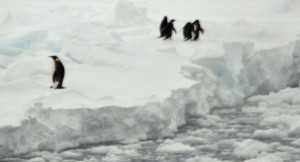“Good morning Ladies and Gentlemen, good morning.”
During the night, we’ve entered the Weddell Sea. The usual morning greeting, from expedition leader Lisa Kelley, comes at 6:30 – earlier than planned. An emperor penguin has been spotted on the ice. It’s unusual this far north, but it’s early in the season, and in this atypically heavy season for ice, we’ve been afford this rare pleasure. “It’s not something you get on every sailing,” says naturalist Eric Guth. Camera shutters whir around us, snapping madly.
The emperor belly flops and toboggans a dozen feet to a group of Adele penguins. Intimidated, they immediately march off out of sight.
It’s a double treat. No sooner have we moved indoors and settled in with coffee then a second emperor is spotted. This one is far closer to the ship, and we’re able to grab photos of his (or her?) head, its eye patch rimmed in yellow. Like other penguins, the emperor colonizes for nesting, but before and after the season they often roam independently – solo travelers on a fish-eating mission. Because its gestation period last so long, emperors lay their eggs in mid-winter; by this part of the summer, their chicks can be left on their own while parents go off to feed.
A thousand images later, the ship sails deeper into the Weddell Sea. A pair of little Adele penguins flap their arms as we steam past their ice floe, as if signaling our path forward. The wind pops up, and they flop onto their bellies. The flurries begin.
Just as lunch approaches, and the jackets and gloves have gone back to their drawyers, Lisa’s mellifluous voice rings through the speakers. A leopard seal has been spotted up ahead. Time to grab the camera.

